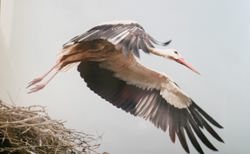The instinct of Fatherland
Every year 25,000 storks return to Ukraine
In a couple of days, on March 19, we will be able to experience a bright emotional moment when we will hear birds that are coming back home. Storks return to Ukraine in spring.
Worldwide globalization is the reason why many people, including quite a few Ukrainians, have a big problem with self-identification: they do not feel they belong to any nation and do not know what state they are serving; they lose a sense of their roots and descent. However, if you look up and see the storks that every March return from Africa to Ukraine, always to the same nest, you will get a good understanding of the instinct that brings these birds home, to their Fatherland.
The birds make their nests at the age of three or four years, when they couple. After this they return to it several years in succession. The reason is a natural instinct. Ukrainians have felt this long ago — for us storks and cranes are the symbols of longing for one’s homeland. We consider storks our birds despite the fact that they spend half of their lives in Africa. But we have more rights: these birds breed in our country.
Ukrainians have plenty of names for these white-and-gray birds: leleky, zhuravli, buzky, and chornohuzy. Ornithologists call them the most conservative birds, because their arrival always takes place in March 20–30. A stork is one of Ukraine’s symbols, which dates back to pagan times, and our ancestors held them in awe. One of Ukrainian names for the stork, leleka, is belived to have come from Lel, the name of the pagan god of love. Since children are born as a result of love, it is no surprise that Ukrainians still have a poetical expression that storks bring children. There is still this superstition that if you see one stork, you will remain single for the whole year, and if you see two, you will be in a couple.
It was not accidental that a literary contest of books for children of young school age is called Golden Stork. The name “Golden Stork” has a double meaning: on the one hand, it is a competition which will give to the youngest children the best, “golden” food — high-quality literature, while on the other hand, it will help discover “golden” children, those who can write nice compositions.
Ukrainians believed that storks make nests only in the yards of good people, where peace, love and harmony reign. However, in recent times storks have built their nests on electric posts, which is very dangerous both for them and the system of electric power transmission. This is the reason why the Lviv region gets ready for the return of storks in a special way: new artificial nests are installed for 84 stork families. Since the birds have made them on pylons, the nests are re-equipped in order to make them safe both for the storks and the electricity cables. Revamping a single nest costs 2,000 hryvnias.
Over 2,000 stork families come to the Lviv region annually, and the return of the first storks is expected on March 15. In general, about 25,000 storks live in Ukraine. They were counted three years ago when a world wildlife protection organizations organized a nationwide “census” of storks as part of its European campaign. In Ukraine questionnaires asking whether any storks live near people’s houses were sent to all schools.
“Traditionally, storks return to Ukraine after March 20, sometimes earlier,” explained Hennadii Fesenko, a junior research fellow at the Institute of Zoology of Ukraine’s National Academy of Sciences. “This is often connected with the conditions of wintering. We usually judge by our winter conditions, but we also need to know how storks have wintered in Africa: whether there was normal humidity or a drought. If everything is normal, some storks may return to their nests even if snow is still lying on the ground in our country.”
Since scientists do not know yet how our storks wintered in Africa, they cannot give a precise date of their return. But in the last few years, when the conditions of wintering were satisfactory in Africa, they tended to return home two weeks ahead of time, in early March. In Ukraine we have most white storks, and that’s the largest population in Europe, whereas there are only several hundred black storks in our country.






